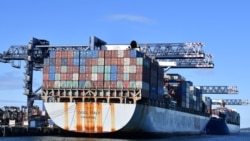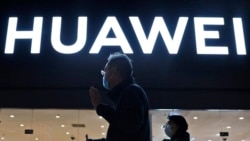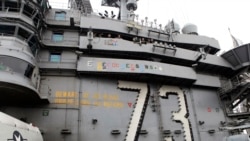China is closely eyeing Australia’s growing military capability with concern.
“As Australia distances itself from China, China feels it’s (Australia) getting closer to the U.S. So, all this running-dog sentiment will surface,” said Oh Ei Sun, senior fellow at the Singapore Institute of International Affairs. Running dog refers to a servile follower.
Over the last decade, Australia has been beefing up its military. China particularly worries about Australia partnering with the United States, the keeper of the world’s strongest armed forces, to check Chinese naval expansion, according to experts.
Already troubled, the once booming Sino-Australian relationship took another downward turn last week when Australia, the United States and the United Kingdom signed a three-way security partnership. The deal, called AUKUS, will allow the sharing of advanced military technology and give Australia eight nuclear-powered submarines.
The AUKUS deal is the latest in a series of events that have caused the relationship between China and Australia to sour. Scholars point to three China-leery prime ministers elected in Australia since 2013, coupled with Canberra’s pushback against Chinese interests in the country, where China looks for prized supplies of iron ore and coal.
“I think it’s a confluence of these few factors which sort of deteriorated the relationship between Australia and China,” said Oh. “There could be encounters between Australian and Chinese ship(s), let’s say, on the South China Sea, which would, of course, further deteriorate the relationship.”
Disputes over Australia’s coveted natural resources, U.S.-backed military clout in the Asia Pacific and politically conservative leaders in Canberra are fueling the decline in relations with China, observers of the two countries said.
Decade of decline
Sino-Australia relations appeared to have a bright future when former Australian Prime Minister Kevin Rudd, a Mandarin speaker, took office in 2007, delighting Chinese leaders.
Two years later, the glow began to fade with the failure of Chinese aluminum corporation Chinalco’s bid to acquire Australian-based mining giant Rio Tinto, followed by a visit to Australia by an anti-China Uyghur independence movement figure, said Fujian Li, a visiting scholar at Future Directions International, a research institute based in Perth.
Some Chinese chafed when Australian mining firms raised the price of iron ore, hurting Chinese interests, Li wrote in a May 2021 paper. These incidents “illustrated that China and Australia disagree on strategy, economy and politics,” he said.
Australia went on to bar Chinese telecom giant Huawei from a national broadband project in 2012 and eventually from participating in Australia’s 5G upgrades. Last year Australia, under Prime Minister Scott Morrison, called for an investigation into China as the source of COVID-19.
China hit back by refusing to accept timber from four Australian states and stranding dozens of bulk carriers carrying Australian coal outside two Chinese ports — with $700 million of coal at stake. Chinese importers had been warned since November to avoid Australian coal. Curbs on wines have hobbled a $724 million market.
“The situation escalated considerably in 2020, when China started to put severe trade measures against some of Australia’s key exports to China,” said Rajiv Biswas, Asia-Pacific chief economist at the market research firm IHS Markit.
What worries China the most
China frets foremost about Australia’s alliance with the United States, a superpower rival of Beijing, analysts said.
Zhao Lijian, a spokesman for the Chinese Ministry of Foreign Affairs, lashed out at the two countries at a news briefing last week.
“The U.S. and Australia are fighting together, deliberately discrediting China for their own geopolitical interests, interfering in China's internal affairs and challenging foreign relations in the region,” he said. “China expresses strong dissatisfaction and firm opposition to this.”
In August, the Chinese embassy in Australia acknowledged a “difficult situation in the bilateral ties.” Three years earlier, Chinese Foreign Minister Wang Yi had asked Australia to step up cooperation with China rather than hinder it.
U.S. warships already pass regularly — 10 times in 2020, for example — through the South China Sea, a waterway that Beijing says falls under its flag, despite the rejection of that claim by an international tribunal five years ago.Washington has tapped Canberra among other Western allies to stand up for freedom of navigation in the sea.
Oh said China is “uneasy” about the Australia-U.S. military equation, the “ideological” ideas of its leaders and growing Australian ties with Southeast Asian countries, including claimants to the South China Sea.
What’s next?
More Chinese economic sanctions against Australia are possible, analysts say, though targeting iron ore or coal could reduce China’s access to needed resources, some experts believe.
Australia is starting to diversify exports into Europe, the Middle East and other parts of Asia, with more room for growth in those regions, they say.
“Australia does have a strategic role in the (Asia Pacific), having strong connections in both Asian and Western countries,” said Stuart Orr, School of Business head at Melbourne Institute of Technology.
But the size of China’s economy means Australia must keep walking a “tightrope,” Biswas said.
China is Australia's largest two-way trading partner accounting for 31% of its global trade — a value of $177.4 billion in 2020, according to the Australian Department of Foreign Affairs and Trade.
“They’ve been waging political warfare since 2015, so we’ve been under the gun for some time,” said Malcolm Davis, senior analyst in defense strategy and capability at the Australian Strategic Policy Institute in Canberra. “They (China) can do all sorts of things to try and make life difficult for us.”












